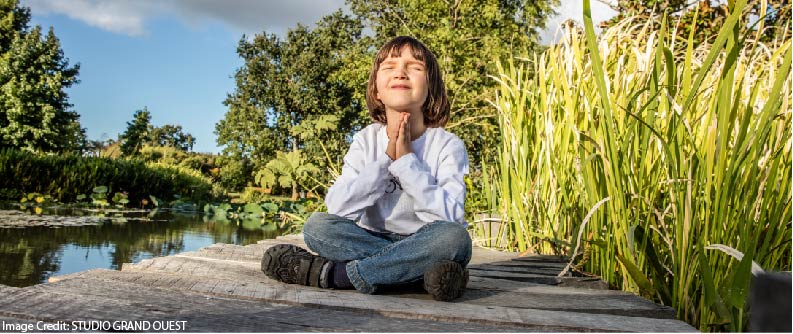
In our frantic, stressed-out, technology-addled world, it just makes sense: we should all take some time to rest our brains.
And: what better way than mindfulness?
We’ve all heard so much about the benefits of focused breathing. The energy that derives from specific poses. The insights that come from curious attention to our bodies.
So: what’s not to love about mindfulness?
Yoga and Mindfulness in 3rd Grade
In 2016 and 2017, researchers worked with high-anxiety 3rd graders at a school in New Orleans.
20 of these students went through a combined yoga and mindfulness program. This program has good research behind it, and was led by an experienced professional. As the researchers describe it,
The session content included breathing exercises, guided relaxation, and several Vinyasa and Ashtanga poses appropriate for third graders.
And, the school devoted real time to this program. Students met before school 10 times, for forty minutes each session. 400 minutes shows real commitment!
Researchers also kept track of 33 other high-anxiety 3rd graders who had been randomly selected as the control group.
Both before and after the yoga/mindfulness program, the students answered a list of questions that measure physical, emotional, and social quality of life. (It’s euphoniously called the PedsQL.)
So: did those 400 minutes help?
The Benefits of Mindfulness
In part, it seems the program helped.
For example, the 3rd graders who participated in yoga and mindfulness saw an increase in their emotional PedsQL score of more than 18 points. Given that the scale ranges from 1 to 100, and that they started with an average score of 52, AND that the control group’s average fell by just under a point — that’s a dramatic improvement!
Researchers also found a statistically significant improvement in their psychosocial PedsQL score.
In a parallel track of this investigation, researchers offered a professional development session on mindfulness for the school’s teachers.
As a result, they found that more teachers used mindfulness and yoga with their students during the class day. Depending on how you count, teachers roughly doubled the number of sessions they used in their classrooms.
So far, so good.
The Perils of Mindfulness Research
Despite all these measurements, I remain unpersuaded by this study.
Three concerns jump out at me.
First: the study includes a control group…but the control group didn’t do anything different from their normal routine. (They were treated for anxiety in the school’s usual way.)
So: the benefits described above might have resulted from the yoga and mindfulness. But, it might just have well resulted from doing something different. Maybe these students would have scored higher on the PedsQL if they’d gone hiking. Or, made music. Or simply arrived at school 40 minutes early and done something relaxing.
We just don’t know.
Second: the students did score higher on the emotional and psychosocial PedsQL, but those are only 2 of the 6 measures on the test. Their scores on the other scales — school, social, physical, and overall — weren’t statistically significantly improved.
In fact, if you look at table 2 instead of table 3, it seems that only the emotional and not the psychosocial scores improved. (Table 3 shows the results of more sophisticated statistical modelling.)
Even in the best case, then, the yoga and meditation helped students on some measures. On 2/3 of the measures, however, it didn’t make a measurable difference.
Third: in this study, classroom teachers started doing additional yoga with their students as well.
So, perhaps the change we saw resulted from the special yoga and mindfulness intervention. Or, perhaps it resulted from the additional classroom yoga. Or, perhaps from the combination.
Again: we just don’t know.
The Perils of Mindfulness Research: The Big Picture
My point here is not to criticize this study. I am, in fact, quite glad that researchers are working with students in schools.
In fact, these researchers — quite helpfully — asked teachers about the biggest impediments for having a mindfulness program in the school.
Instead, I want to highlight how difficult it is to be confident about cause and effect.
In truth, I really want to be persuaded. I want to be able to tell teachers that we’ve got a sure-fire solution to real school problems.
But, my desire to be persuaded means I must be especially vigilant about the research I rely on.
In fact, as noted before on this blog, research in this field isn’t improving as fast as we’d like it to.
Ultimately, if we’re going to tell students to come to school early, if we’re going to ask them to spend 400 minutes doing something, if we’re going to create new programs and hire more staff, we need to be sure that this cause produces this effect.
As of today, I don’t think we’re sure enough.





